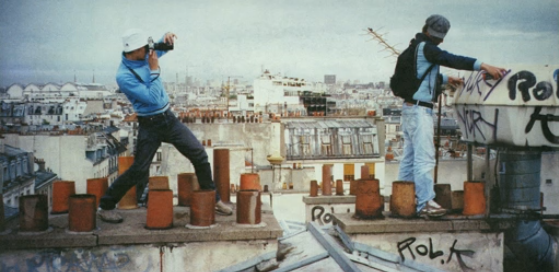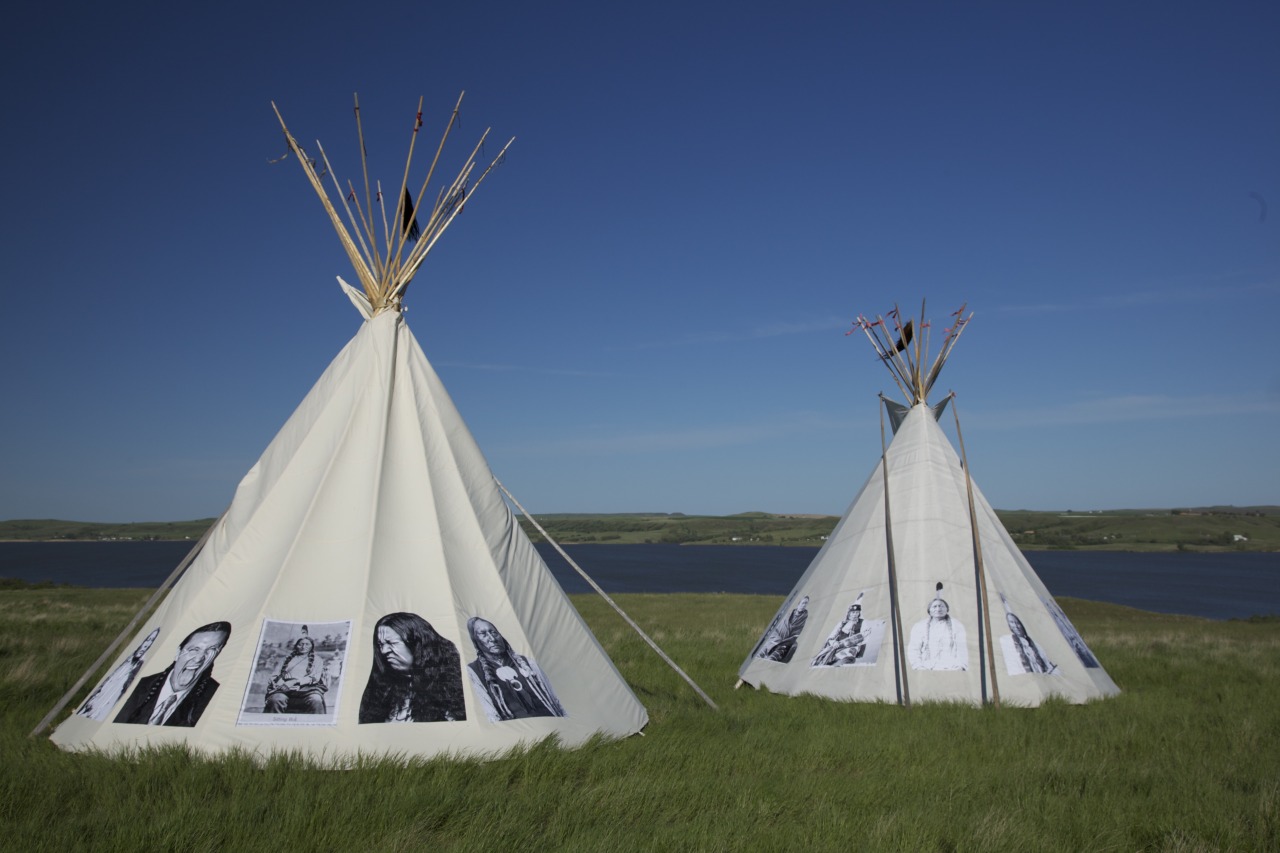It started in a bourgeois neighborhood in Paris about seven years ago when larger than life portraits of “thugs” were pasted up on the sides of buildings, on bus stops and billboards.
 Photo from JR’s website
Photo from JR’s website
This was JR’s first series, 28 Millimètres: Portraits of a Generation. It was called so because he used a 28 millimetre lens to take the photographs, meaning he was less than a foot away from his subjects. It wasn’t long before this that JR became interested in photography at all. And it started simply because he stumbled upon a camera abandoned on the Metro.
 Photo: Screenshot from TED video
Photo: Screenshot from TED video
The theme stuck. A “photograffeur” (as he calls himself – a mix of photographer and graffiti artist), JR made a name for himself over the years that followed (those he has chosen to keep his real identity anonymous as it makes it easier for him to travel). He continues taking portrait photographs, blowing them up in large formats and pasting them in public places, often in deprived areas or those in the midst of political crisis.
 Photo: from the Women Are Heroes series in Kibera Slum (one of the largest in Africa), Kenya, 2009 from JR’s website
Photo: from the Women Are Heroes series in Kibera Slum (one of the largest in Africa), Kenya, 2009 from JR’s website
His goal is to start a conversation about the state of our world and the people who live within it. And his art has started many. He’s been around on the scene for a while and this story isn’t new, but the influence of his project is still spreading. He recently released an iPad app with a map of his work around the globe to make it easier for people to find the portraits.
 Photo: In Ghana, 601 portraits of children who witnessed acts of violence against their mothers, sister or themselves were pasted up outdoors. Image from JR’s website.
Photo: In Ghana, 601 portraits of children who witnessed acts of violence against their mothers, sister or themselves were pasted up outdoors. Image from JR’s website.
Last year, JR also put together a digital book featuring portraits of senior citizen that he pasted in California. It was called Wrinkles of the City, Los Angeles.
Video: JR’s Wrinkles of the City, Los Angeles project by MOCATV
Around this time, he collaborated with Cuban-American artist José Parlá to put together a Wrinkles of the City series in Havana, Cuba, with portraits of those who lived through the Cuban Revolution.
 Photo: After the Wrinkles in the City, Havana was completed, JR and José Parlá brought this featured couple a copy the book. Image from JR’s website.
Photo: After the Wrinkles in the City, Havana was completed, JR and José Parlá brought this featured couple a copy the book. Image from JR’s website.
The Wrinkles of the City project actually started back in 2008 in Cartagena, Spain, where people who lived through the civil war were photographed. The resulting images were pasted on the sides of crumbling buildings or rusted structures.
 Photo: Wrinkles of the City, Cartagena from JR’s website
Photo: Wrinkles of the City, Cartagena from JR’s website
Shanghai, was next. In 2010, JR pasted portraits with the aim of highlighting the importance of the elderly in society and the lessons they have to pass on to the generations to come.
 Photo: from the Wrinkles of the City, Shanghai series. Image from JR’s website.
Photo: from the Wrinkles of the City, Shanghai series. Image from JR’s website.
2010 was also the year that another project (one of my favorites) – Women are Heroes – was turned into a film which was shown at the Cannes Film Festival. Women are Heroes, as a project, took JR around the world for two years between 2008-2010 including this incredible work in the notoriously dangerous Morro da Providência favela in Brazil.
 Photo: Rio de Janeiro favela at night from JR’s website
Photo: Rio de Janeiro favela at night from JR’s website
He traveled with groups of friends to find women with stories to tell who were willing to be photographed. They went everywhere from Cambodia to India to Sierra Leone to Liberia and beyond.
Video: JR’s Women are Heroes project in Brazil by MOCATV
One of the reasons that JR’s work is so stunning to me is its combination of three of my favorite things: photography, street art and travel. Another reason is that it also shares a real perspective of the lives of locals living in places torn to pieces by violence or poverty and then sensationalized by the media. I love that he gets out there and talks to communities, asks questions and learns about their daily lives. Then he shares their stories. And he does it in a way that’s pretty difficult to ignore.
 Photo: Separation Wall, Palestinian Side In Bethlehem, March 2007 from JR’s website
Photo: Separation Wall, Palestinian Side In Bethlehem, March 2007 from JR’s website
JR is the same age as me, born in 1983, in France. In 2011, he became the youngest winner of the prestigious TED Prize. With this prize, he was asked to make a wish that could change the world and given $100,000 to help make it happen. The wish? To turn the world inside out through art. The idea is to get the whole world involved in creating portrait style photographs that they could upload to a website, be sent a poster version and instructions on how to paste it and then put it up as part of a community project somewhere powerful that made sense. This video from TED below is definitely worth watching.
Video from TED
JR goes in with a sense of humour and one of my favorite stories from this video is about his trip to India for the Women are Heroes project. With a group of friends, he tried to post portraits on the walls, but the authorities weren’t having it. Eventually they got away with posting white pieces of paper which confused everyone, but they were sticky on one side so as the dust rose up from the city streets, the portraits revealed themselves.
 Photo: In Jaipur during Holi Festival with JR eyes revealed through paint powder from JR’s website
Photo: In Jaipur during Holi Festival with JR eyes revealed through paint powder from JR’s website
The Inside Out project that came from JR’s TED wish has attracted quite a bit of attention, even from a group of Native Americans on Standing Rock Reservation in North Dakota.
 Photo: Taken in North Dakota for the Inside Out project.
Photo: Taken in North Dakota for the Inside Out project.
Here’s a trailer for the project with some more examples of the work:
Video from TheInsideOutChannel
JR gets up to plenty of interesting stuff. I don’t believe he posted any work while he was there, but last summer, JR instagramed his trip to North Korea – not something you see everyday, especially now.
 Photo: An instagram shot form JR’s trip to North Korea. Image from his blog.
Photo: An instagram shot form JR’s trip to North Korea. Image from his blog.
One other JR art project that was pretty amazing was Face to Face which took place around 2007. With the help of a few friends, JR spent some time in Israel and Palestine photographing people on each side who do the same jobs – two taxi drivers, two teachers, two lawyers, two hairdressers – making funny faces. He took these images of people who agreed to be pasted next to their counterpart from the opposite side and pasted them in eight Israeli and Palestinian cities on both sides of the separation wall. When asked who was from which side, most people couldn’t guess.
 Photo: Two actor. Image from JR’s website.
Photo: Two actor. Image from JR’s website.
This article link is from 2011, but worth a read – JR talks to the New York Times. As he explains while talking about his passion for his work, “One of the things that touches me most is injustice. I’m of mixed origins — North Africa, Eastern Europe, Spain — and this generation today, we’re all a little bit from everywhere. My parents were born abroad. I was born in France, but I feel comfortable everywhere — I don’t see the borders.”
 Photo: La Havana, Alicia Adela Hernandez Fernández, Cuba, 2012 from JR’s website
Photo: La Havana, Alicia Adela Hernandez Fernández, Cuba, 2012 from JR’s website
(By the way, look closely at the very first photo in this entry. If you didn’t already notice, you’ll see it’s not a gun as it first appears, but a video camera.)
Here’s a schedule if you want to find out when JR is exhibiting in your city.

2 Comments
Rich
April 28, 2013 at 4:50 pmInteresting read.
littleobservationist
April 28, 2013 at 4:51 pmCheers 🙂